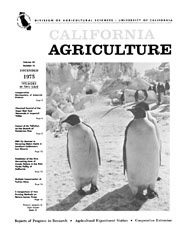All Issues









Volume 29, Number 12












|
|||
|
|||

Cover:
Top shows boom-shaker in pistachio nut orchard. Bottom shows nuts harvested
by boom-shaking (left) and (right) by handstripping those remaining after shaking.

Cover:
Feeding time at the Norman Feedlot, San Jacinto. See “Time of Processing
Effects on Feedlot Calves,” - Photo by Max Clover.

Cover:
Damage carsed by sorghum midge. Severely blasted head on right; undamaged head on left.

Cover:
It’s a real eyepopper of an idea, but U.C. Davis student Raymond Sunseri doesn’t think any human can eat a cow’s breakfast. However, these rice straw cubes, as well as other alternative and by-product cattle feeds now under development by U.C. researchers, may be staple feed for animals of the future. This project and other work to enhance the world‘s food supply was explained by students and faculty at the Davis campus as part of this year’s Picnic Day actiuities - Photo by Tracy Borland

Cover:
Pollinating tiny wild tomatoes from Peru in search for new genetic strains to improve nutritional qualities and disease resistance in US. tomato varieties - U.C. Davis.

Cover:
Moth introduced for biological control of Russian thistle: (top) adult Coleophora parthenica, 12x; (lower left) egg of moth, 30x; (lower right) larva in stem of thistle, lox.

Cover:
Almond branch showing severe failure of leaf buds; flower buds have bloomed and set fruit.

Cover:
California's beef industry from early longhorn to today's modern beef animal (see centennial series article).

Cover:
Walnut hedger with seven circular saw blades on two booms, allowing trimming without turning around.
December 1975
Volume 29, Number 12 News and opinion |
|||
|
University of California, 1301 S. 46th St., Bldg. 478 Richmond, CA
|